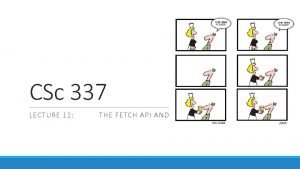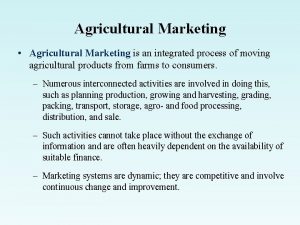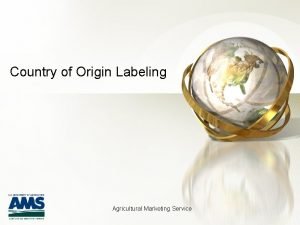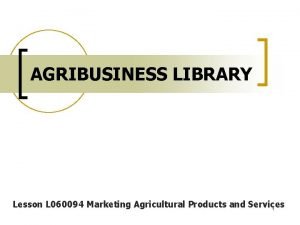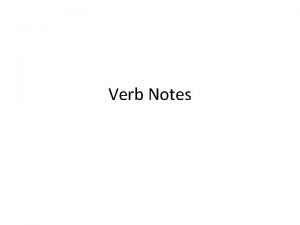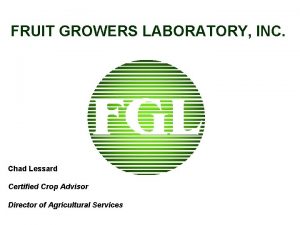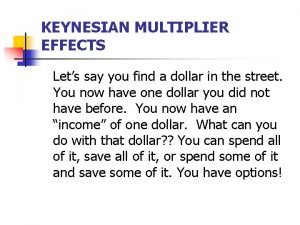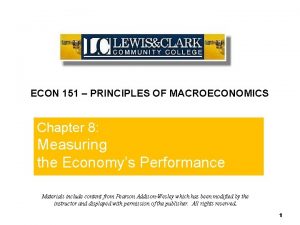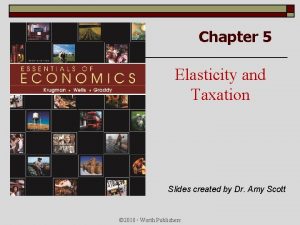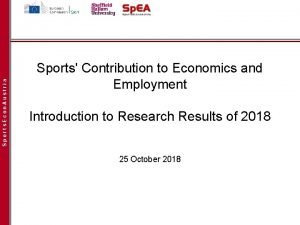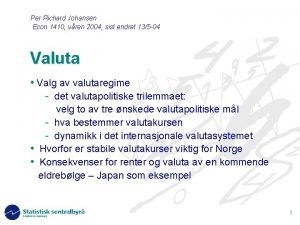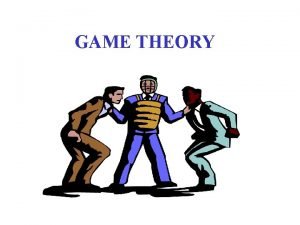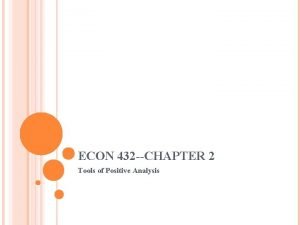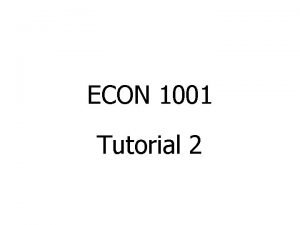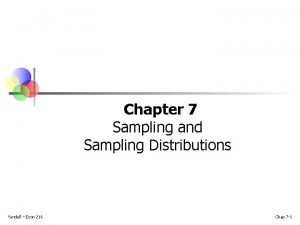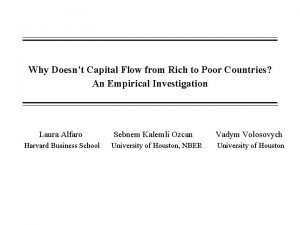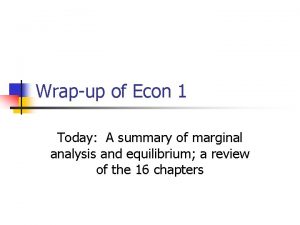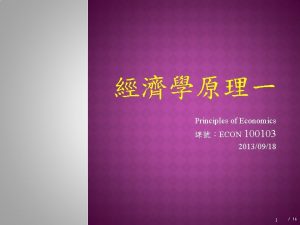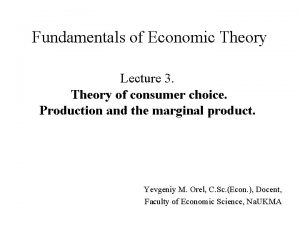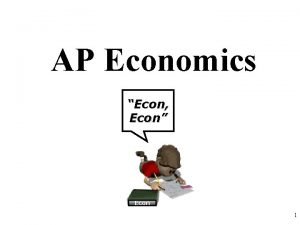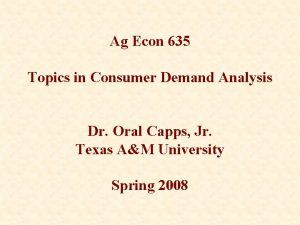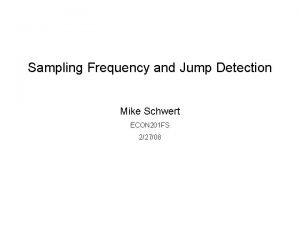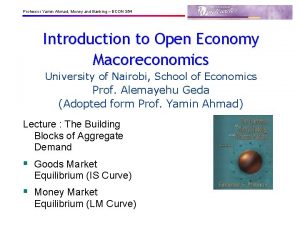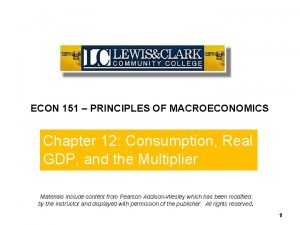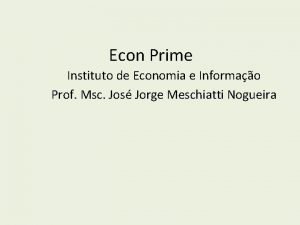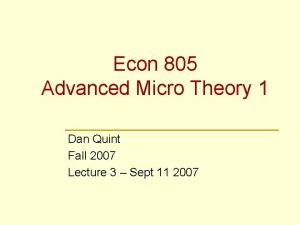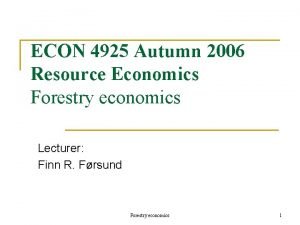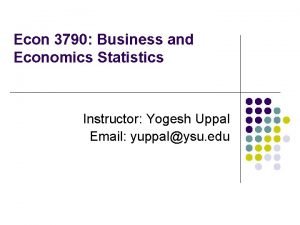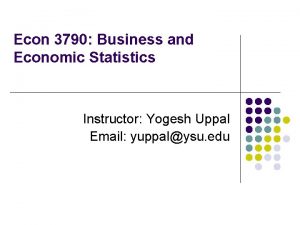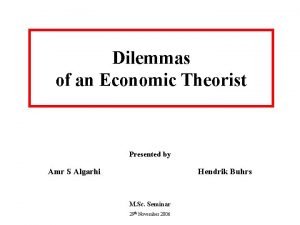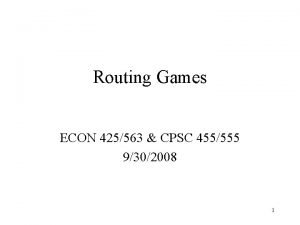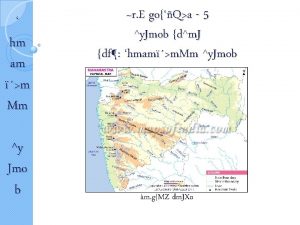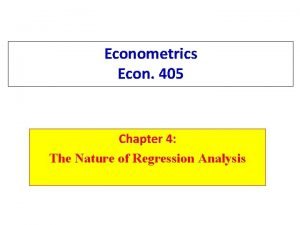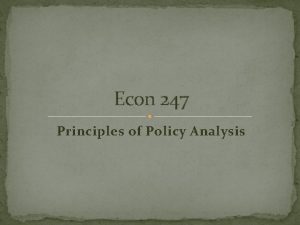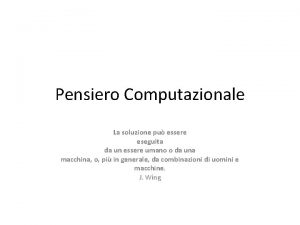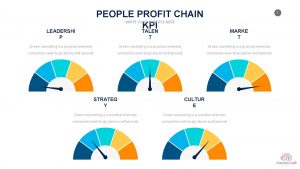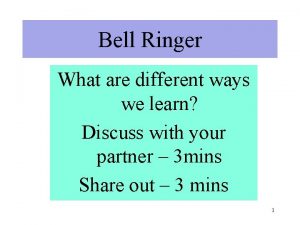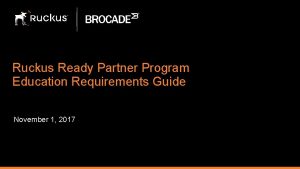ECON 337 Agricultural Marketing Chad Hart Associate Professor







































































































































- Slides: 135

ECON 337: Agricultural Marketing Chad Hart Associate Professor chart@iastate. edu 515 -294 -9911

CME Group Øhttp: //www. cmegroup. com/ ØProducts ØAgricultural commodities ØCorn, soy, cattle, hogs, etc. ØEnergy ØCurrency ØMetals ØWeather ØOthers

Futures Contracts Ø A legally binding contract to make or take delivery of the commodity ØTrading the promise to do something in the future ØYou can “offset” your promise Ø Standardized contract ØForm (weight, grade, specifications) ØTime (delivery date) ØPlace (delivery location)

Soybean Futures Ø Form Ø 5, 000 bushels ØNo. 2 Yellow Soybeans (at price), No. 1 Yellow soybeans (at 6 cents over price), and No. 3 Yellow Soybeans (at 6 cents under price) Ø Time ØContract months: Sept, Nov, Jan, Mar, May, July, and August Source: CME Group

Delivery Points Corn Soybeans Wheat Source: Irwin, Garcia, Good, and Kunda, 2009 Marketing and Outlook Research Report 2009 -02

Futures Contracts Ø No physical exchange takes place when the contract is traded (no actual commodity moves) Ø Payment is based on the price established when the contract was initially traded (prices can and will change before delivery is taken) Ø Deliveries can be made when the contract expires or the offsetting futures position must be taken to settle up Ø Deliveries occur on less than 5 percent of the traded contracts

Market Positions Ø You can either buy or sell initially to open a position in the futures market Ø“Make” a promise to make or take delivery Ø Do the opposite to close the position at a later date Ø“Offset” the promise (and no commodity changes hands) Ø Trader may also hold the position until expiration and make or take physical delivery of the commodity

Trading Futures Contracts Ø All trades through a licensed broker Ø Brokerage house has a “seat” at the exchange and is allowed to trade ØRepresented “on the floor” to exercise trade ØLocal broker to initiate transaction and manage account with client ØFull service and discount brokers

CME Group Øhttp: //www. cmegroup. com/ ØOpen, High, Low, Last Price ØSettlement Price ØVolume ØOpen Interest ØDaily Limits

Cash vs. Futures Prices Iowa Corn in 2016 The gap between the lines is the basis.

Market Participants Ø Hedgers are willing to make or take physical delivery because they are producers or users of the commodity ØUse futures to protect against a price movement ØCash and futures prices are highly correlated ØHold counterbalancing positions in the two markets to manage the risk of price movement

Hedgers Ø Farmers, livestock producers Ø Merchandisers, elevators Ø Food processors, feed manufacturers Ø Exporters Ø Importers What happens if the futures market is restricted to only hedgers?

Market Participants Ø Speculators have no use for the physical commodity ØThey buy or sell in an attempt to profit from price movements ØAdd liquidity to the market Ø May be part of the general public, professional traders or investment managers ØShort-term – “day traders” ØLong-term – buy or sell and hold

Market Participants Ø Brokers exercise trade for traders and are paid a flat fee called a commission Ø Futures are a “zero sum game” ØLosers pay winners ØBrokers always get paid commission

Hedging Ø Holding equal and opposite positions in the cash and futures markets Ø The substitution of a futures contract for a later cash-market transaction Ø Who can hedge? ØFarmers, merchandisers, elevators, processors, exporter/importers

Cash vs. Futures Prices Iowa Corn in 2016

Short Hedgers Ø Producers with a commodity to sell at some point in the future ØAre hurt by a price decline Ø Sell the futures contract initially Ø Buy the futures contract (offset) when they sell the physical commodity

Short Hedge Example Ø A soybean producer will have 25, 000 bushels to sell in November Ø The short hedge is to protect the producer from falling prices between now and November Ø Since the farmer is producing the soybeans, they are considered long in soybeans

Short Hedge Example Ø To create an equal and opposite position, the producer would sell 5 November soybean futures contracts Ø Each contract is for 5, 000 bushels Ø The farmer would short the futures, opposite their long from production Ø As prices increase (decline), the futures position loses (gains) value

Short Hedge Expected Price Ø Expected price = Futures prices when I place the hedge + Expected basis at delivery – Broker commission

Short Hedge Example Ø As of Jan. 20, Nov. 2017 soybean futures Historical basis for Nov. 0. 30 Rough commission on trade Expected price ($ per bushel) $10. 29 $$-0. 01 $ 9. 98 Ø Come November, the producer is ready to sell soybeans Ø Prices could be higher or lower Ø Basis could be narrower or wider than the historical average

Prices Went Up, Hist. Basis Ø In November, buy back futures at $11. 50 per bushel Nov. 2017 soybean futures Actual basis for Nov. Local cash price Net value from futures ($ per bushel) $11. 50 $-0. 30 $11. 20 $-1. 22 ($10. 29 - $11. 50 - $0. 01) Net price $ 9. 98

Prices Went Down, Hist. Basis Ø In November, buy back futures at $7. 00 per bushel Nov. 2017 soybean futures Actual basis for Nov. Local cash price Net value from futures ($ per bushel) $ 7. 00 $-0. 30 $ 6. 70 $ 3. 28 ($10. 29 - $7. 00 - $0. 01) Net price $ 9. 98

Short Hedge Graph Hedging Nov. 2017 Soybeans @ $10. 29

Prices Went Down, Basis Change Ø In November, buy back futures at $7. 00 per bushel Nov. 2017 soybean futures Actual basis for Nov. Local cash price Net value from futures ($ per bushel) $ 7. 00 $-0. 10 $ 6. 90 $ 3. 28 ($10. 29 - $7. 00 - $0. 01) Net price Ø Basis narrowed, net price improved $10. 18

Hedging Results Ø In a hedge the net price will differ from expected price only by the amount that the actual basis differs from the expected basis. Ø So basis estimation is critical to successful hedging. Ø Narrowing basis, good for short hedgers, bad for long hedgers Ø Widening basis, bad for short hedgers, good for long hedgers

Basis Ø Basis = Cash – Futures Ø Futures reflect global supply and demand Ø Basis reflects local supply and demand Ø Cash = Futures + Basis

Basis Basics Ø Specific to time and place Ø Typically use nearby futures Ø Convergence Ø Less variable than cash prices Ø Relatively predictable

Basis Factors Ø Relative storage capacity Ø Transportation availability and cost Ø Time to expiration Ø Quality issues

Average Iowa Corn Basis, 2010 -14 Source: http: //www. extension. iastate. edu/agdm/crops/pdf/a 2 -41. pdf

Basis Information ISU Extension and Outreach, Ag Decision Maker Ø Ø Corn http: //www. extension. iastate. edu/agdm/crops/html/a 2 -41. html Soy http: //www. extension. iastate. edu/agdm/crops/html/a 2 -42. html Cattle http: //www. extension. iastate. edu/agdm/livestock/html/b 2 -42. html Hogs http: //www. extension. iastate. edu/agdm/livestock/html/b 2 -41. html USDA-Ag. Marketing Service Ø http: //www. ams. usda. gov/mnreports/lsddgr. pdf Ø http: //www. ams. usda. gov/mnreports/nw_gr 110. txt Local elevators, ethanol plants, processing plants, etc.

Cash Contracts Ø When we talk about a cash contract, it is an agreement between a seller and a buyer covering a quantity and quality of a product to be delivered at a specified location and time for a specific price Ø If the time is now, we call it a “cash” contract Ø If the time is sometime in the future, then it’s a “forward cash” contract

The Highest Cash Price Is … … Not always the highest return Need to think about transportation and storage costs Compare the cash prices we’ve seen today: Ø If storage is costing me 3 cents/bushel/month, do the May bids look better than the current cash price? Ø If transportation is costing me 0. 5 cents/bushel/mile, which is the better price? Boone (16 miles) Gilbert (8 miles) Nevada (10 miles) Alleman (16 miles) Eddyville (100 miles)

Cash vs. Futures Hedge Ø Cash Sales Ø Locks in full price and delivery terms Ø No margin requirements Ø Futures Hedge Ø Locks in futures price, but leaves basis open Ø Could see price improvement/loss Ø Can be easily offset if problems arise

Options Ø What are options? Ø An option is the right, but not the obligation, to buy or sell an item at a predetermined price within a specific time period. Ø Options on futures are the right to buy or sell a specific futures contract. Ø Option buyers pay a price (premium) for the rights contained in the option.

Option Types Ø Two types of options: Puts and Calls Ø A put option contains the right to sell a futures contract. Ø A call option contains the right to buy a futures contract. Ø Puts and calls are not opposite positions in the same market. They do not offset each other. They are different markets.

Put Option Ø The Buyer pays the premium and has the right, but not the obligation, to sell a futures contract at the strike price. Ø The Seller receives the premium and is obligated to buy a futures contract at the strike price if the Buyer uses their right.

Call Option Ø The Buyer pays a premium and has the right, but not the obligation, to buy a futures contract at the strike price. Ø The Seller receives the premium but is obligated to sell a futures contract at the strike price if the Buyer uses their right.

Options as Price Insurance Ø The person wanting price protection (the buyer) pays the option premium. Ø If damage occurs (price moves in the wrong direction), the buyer is reimbursed for damages. Ø The seller keeps the premium, but must pay for damages.

Options as Price Insurance Ø The option buyer has unlimited upside and limited downside risk. ØIf prices moves in their favor, the option buyer can take full advantage. ØIf prices moves against them, the option seller compensates them. Ø The option seller has limited upside and unlimited downside risk. ØThe seller gets the option premium.

Option Issues and Choices Ø The option may or may not have value at the end Ø The right to buy corn futures at $6. 00 per bushel has no value if the market is below $6. 00. Ø The buyer can choose to offset, exercise, or let the option expire. Ø The seller can only offset the option or wait for the buyer to choose.

Strike Prices Ø The predetermined prices for the trade of the futures in the options Ø They set the level of price insurance Ø Range of strike prices determined by the futures exchange

Options Premiums Ø Determined by trading in the marketplace Ø Different premiums Ø For puts and calls Ø For each contract month Ø For each strike price Ø Depends on five variables Ø Strike price Ø Price of underlying futures contract Ø Volatility of underlying futures Ø Time to maturity Ø Interest rate

Option References Ø In-the-money Ø If the option expired today, it would have value Ø Put: futures price below strike price Ø Call: futures price above strike price Ø At-the-money Ø Options with strike prices nearest the futures price Ø Out-of-the-money Ø If the option expired today, it would have no value Ø Put: futures price above strike price Ø Call: futures price below strike price

Options Premiums Dec. 2017 Corn Futures $3. 93 per bu. In-the-money Out-of-the-money In-the-money

Setting a Floor Price Ø Short hedger Ø Buy put option Ø Floor Price = Strike Price + Basis – Premium – Commission Ø At maturity Ø If futures < strike, then Net Price = Floor Price Ø If futures > strike, then Net Price = Cash – Premium – Commission

Put Option Graph Dec. 2017 Corn Futures @ $3. 9325 Strike Price @ $4. 00 Put Option Return = Max(0, Strike Price – Futures Price) – Premium – Commission Premium = $0. 3425 Commission = $0. 01

Put Option Graph Dec. 2017 Corn Futures @ $3. 9325 Premium = $0. 3425 Net = Cash Price + Put Option Return Strike Price @ $4. 00

Short Hedge Graph Sold Dec. 2017 Corn Futures @ $3. 9325 Net = Cash Price + Futures Return

Comparison

Out-of-the-Money Put Dec. 2017 Corn Futures @ $3. 9325 Strike Price @ $3. 00 Premium = $0. 0175

In-the-Money Put Dec. 2017 Corn Futures @ $3. 9325 Strike Price @ $5. 00 Premium = $1. 12625

Comparison

Call Option Graph Dec. 2017 Corn Futures @ $3. 9325 Strike Price @ $4. 00 Call Option Return = Max(0, Futures Price – Strike Price) – Premium – Commission Premium = $0. 2875 Commission = $0. 01

Summary on Options Ø Buyer ØPays premium, has limited risk and unlimited potential Ø Seller ØReceives premium, has limited potential and unlimited risk Ø Buying puts ØEstablish minimum prices Ø Buying calls ØEstablish maximum prices

Option Premiums Ø Can be divided into two sections: ØIntrinsic value ØWhat is the option worth today? ØTime value ØHow much time is left on the option? Intrinsic value depends on the futures price and the strike price of the option. Time value depends on the length of time in the option and the price volatility in the market.

Option Premiums Intrinsic value will not be less than zero. Remember, you have the right to exercise an option, not the obligation. So if the option is losing money, you can just let it expire. Time value will gradually approach zero as the expiration date approaches. Option premium = Intrinsic value + Time value

Example Start with an December 2017 corn put option @ $3. 90 per bushel Day 1 Futures Price $3. 855 Option Premium $0. 32375 Intrinsic Value $0. 045 Time Value $0. 27875 2 3 4 5 $3. 8725 $3. 9625 $3. 945 $3. 9325 $0. 31125 $0. 27375 $0. 28375 $0. 29125 $0. 0275 $0. 00 $0. 28375 $0. 27375 $0. 28375 $0. 29125

Combination Strategies Ø Option fence ØBuy put and sell call Ø Put spread ØBuy In-the-money or At-the-money put and sell Out-of-the-money put

Option Returns in a Fence Buy Put Option Dec. 2017 Corn @ $3. 50 Premium = $0. 10625 Sell Call Option Dec. 2017 Corn @ $4. 50 Premium = $0. 14625

Fence for Hedger Buy Put Option Dec. 2017 Corn @ $3. 50 Premium = $0. 10625 Sell Call Option Dec. 2017 Corn @ $4. 50 Premium = $0. 14625

Option Returns in Spread Buy Put Option Dec. 2017 Corn @ $4. 50 Premium = $0. 6975 Sell Put Option Dec. 2017 Corn @ $3. 50 Premium = $0. 10625

Spread for Hedger Sell Put Option Dec. 2017 Corn @ $3. 50 Premium = $0. 10625 Buy Put Option Dec. 2017 Corn @ $4. 50 Premium = $0. 6975

Combination Strategies Ø Butterfly Ø Straddle Ø Condor Ø Strangle Ø These positions can be flipped

Condor Sell Put @ $3. 00 Premium = $0. 0175 Buy Put @ $4. 00 Premium = $0. 3425 Sell Call @ $6. 00 Premium = $0. 02875 Buy Call @ $5. 00 Premium = $0. 07875

Condor for Hedger

The 4 Basic Graphs for Options Ø Buy a put Ø Sell a put Ø Buy a call Ø Sell a call

Seasonal Patterns Ø A price pattern that repeats itself with some degree of accuracy year after year. ØSupply and demand ØOften sound reasons ØWidely known ØLinked to storage cost or basis patterns in grains ØLinked to conception and gestation in livestock

Seasonal Pricing Patterns Source: USDA, NASS, Monthly Price Data 1980 -2013

Corn Pricing Patterns Source: USDA, NASS, Monthly Price Data 1980 -2013

Soybean Pricing Patterns Source: USDA, NASS, Monthly Price Data 1980 -2011

Charting Channel lines

Sell Signal A sell signal is one close below the charting lines Sell signal

Buy Signal Some chartists need only one close above the charting line to create a buy signal, others use two closes above. Buy signal

Resistance and Support Resistance level: A price level where the market seems to hit and bounce down Support level: A price level where the market seems to hit and bounce up

Key Reversal A key reversal is when the daily high and low price range exceed the price range for the previous two days.

Gaps often occur when a major new piece of information hits the market. They are often filled in by later price movements.

Double Tops & Bottoms Double tops and bottoms show prices with major technical resistance. These can be several days apart.

Head & Shoulders Source: Figure 7, Charting Commodity Futures Ag Decision Maker, File A 2 -20

Moving Averages 9 day average 18 day average 40 day average Sell signal Buy signals

Does Technical Analysis Work? Arguments for it: ØReal world markets are not perfectly rational ØMarkets may be slow to respond to new information ØTechnical analysis works with the psychological biases ØIt works because so many people use it ØSelf-fulfilling Arguments against: ØEfficient market hypothesis ØThe current price holds all of the relevant information

Carry (or Spread) The price difference between futures contracts Compare the carry offered by the market to the costs of storing grain from one delivery month to the next.

Inverse Carry When further out futures are priced at a discount to nearby futures Usually occurs when demand is strong and the need for the crop is immediate Can also occur during short crop situations or when there is a large crop coming in after a tight stock situation Basis is usually stronger in an inverse market

Cost of Ownership Carry shows the additional revenue that can be obtained from holding on to the crop But there are costs to holding on: storage interest/opportunity costs These are known as the cost of ownership If the carry more than covers the cost of ownership, then it’s referred to as “full carry”

Storage Typically, storage costs can be broken down into two categories An in-out charge: sort of like a flat upfront fee Periodic charge: the additional cost for each time period - Could be monthly, weekly, or daily Charges vary by location (on-farm vs. off-farm)

Interest/Opportunity Costs associated with the lost opportunities you could have had if you sold the grain at harvest and reinvested the proceeds Figured as: Cash price at harvest * Short term interest rate * Months in storage / 12 Or the opportunity cost for each month in storage is: (1/12)* Cash price at harvest * Interest rate

Corn Cost of Ownership Assumption: Corn is Valued at $3. 05/bu Financed @ 5% APR

Soybean Cost of Ownership Assumption: Soybeans are Valued at $9. 06/bu Financed @ 5% APR

Other Factors Moisture levels and drying costs Shrink factor Transportation costs Quality issues Helpful tool to evaluate costs: http: //www. extension. iastate. edu/agdm/crops/xls/a 2 -33. xls

Seasonal Pricing Patterns Source: USDA, NASS, Monthly Price Data 1980 -2016

Corn Prices vs. Marketings Sources: USDA, NASS & ERS Monthly Price Data 1980 -2016

Soy Prices vs. Marketings Sources: USDA, NASS & ERS Monthly Price Data 1980 -2016

Iowa Storage Capacity Source: USDA-NASS

U. S. Storage Capacity Source: USDA-NASS

Storage Issues Source: Hurburgh and Elmore, ICM News, 10/15/09

Why Should you have a Marketing Plan? • Detached from the decision • Proper perspective • Introduces discipline and consistency • Check your logic • What if…

Fear, Greed, and Ego Fear of making a bad decision -- Watching prices slip away as you wait -- Watching prices rise after you’ve sold Greed of expecting even higher prices -- Not taking advantage of good price opportunities Ego of wanting to claim you caught the market high -- “Lake Wobegon” marketing

ar ed Fe G re Ego

What is a Marketing Plan? A marketing plan is an outline of price, date, and quantity objectives used to generate a reasonable return given the existing market conditions.

8 -Step Marketing Plan 1. Describe your current operation 2. Specify goals 3. Know your costs of production and break-even 4. Utilize sound market information 5. Set target prices 6. Evaluate pricing alternatives and actions − Cash, futures/options, forward contract 7. Execute when target prices are hit 8. Review and evaluate results

1. Describe your current operation… • • • Annual marketing's: number, weight, timing of sales Input purchases: feeders, feed needs, crop inputs Cost of production: cash and total costs Alternative market outlets: distance, transportation costs Marketing philosophy: sell on tight schedule, shop for best price, standing order • Attitude toward price risk and knowledge of risk management tools • Where are you going?

2. Specify goals… • • Manage risk and protect profit potential Goals should be achievable and measurable If and when consistently met – revise upward Examples: − Selling price 5% higher than the auction or plant average − Sell in top 1/3 of price range − Cover total costs plus growth requirements − Cover cash requirements

3. Know your costs of production and break-even… • Production history and expectations • Incorporate input quantities and prices • Project costs on per unit sold − Variable $/unit − Total $/unit • Budgeting tools available − http: //www. extension. iastate. edu/agdm/livestock/ html/b 1 -21. html

3. Know your costs of production and break-even… • Project a break-even level − Price to cover variable costs − Price to cover fixed costs − Price to cover profit and growth • Sensitivity analysis for key variables • Back calculate from revenue to what you can afford to pay for feeder animals

4. Utilize sound market information… • Factors that impact price − Supply − Demand and supply balance • Systematic price variations − Trends − Cyclical movements (cattle cycle, hog cycle, etc. ) − Seasonal price patterns

4. Utilize sound market information… • Market information and projections − USDA reports (weekly, monthly, annual) − Extension forecast/outlook reports − Commodity organizations − Newsletters − Private marketing firms

5. Set target prices… • Set target prices based on actual or accurately estimated production costs • Know what the market is paying (or expected to pay) • The level and timing of target prices based on: − Market outlook information − Cost of production figures − Cash flow needs • Advantageous to set several target prices − Allows for changing market trends

6. Evaluate pricing alternatives and actions…

6. Evaluate pricing alternatives and actions… Method Advantages Disadvantages Cash sales • Easy to transact • Immediate payment • No set quantity • Minimize risk • No price protection • Less flexible Forward contract • • • Must deliver in full • Opportunity loss if prices rise Futures contract • Easy to enter/exit • Minimize risk • Often better prices than forward contracts • • Options contract • • • Premium cost • Set quantities • Commission cost Easy to understand Flexible quantity Locked-in price Minimize risk Price protection Minimize risk Benefit if prices rise Easy to enter/exit Opportunity loss if prices rise Commission cost Performance bond calls Set quantities

7. Execute when target prices are hit… Price Target 1 2 3 4 5 6 7 Futures Price 50. 72 76. 24 79. 19 82. 14 86. 19 90. 25 94. 30

8. Review and evaluate results… • Check performance relative to marketing goals • Biggest reason for failure to repeatedly use marketing plans is that performance is compared to what might have been − Typically the highest price alternative − Probably an unrealistic goal • No one strategy is best all the time • Are conditions changing?

What Makes a Marketing Plan Work? • Know your market positions − Track all positions – where do you stand on % sold and average price? • Make the plan manageable − Don’t expect to achieve your highest targets − Focus on only tools you feel comfortable using − Set price targets that are realistic − Use multiple sources of analysis

A Little Marketing Philosophy • Bad outcomes still happen… • Never compare to the market high… • Remember it’s your plan for your operation…

Dec. Corn Futures Source: CBOT, Futures Price for 2 nd Friday of the month

Dec. Corn Futures 2000 2001 2002 2003 2004 2005 2006 2007 2008 2009 2010 2011 2012 2013 2014 2015 2016 Nov 2. 34 2. 53 2. 46 2. 41 2. 48 2. 40 2. 43 3. 45 4. 32 4. 43 4. 37 5. 09 5. 74 6. 30 4. 69 4. 24 3. 88 Dec 2. 28 2. 52 2. 40 2. 41 2. 50 2. 33 2. 41 3. 50 4. 51 4. 20 4. 38 5. 29 5. 52 6. 28 4. 53 4. 32 3. 96 Jan 2. 49 2. 54 2. 39 2. 41 2. 53 2. 29 2. 49 3. 95 5. 13 4. 54 4. 06 5. 71 5. 55 5. 77 4. 58 4. 22 3. 85 Feb 2. 52 2. 45 2. 31 2. 45 2. 81 2. 30 2. 57 3. 99 5. 30 4. 06 3. 97 6. 18 5. 60 5. 63 4. 60 4. 18 3. 82 Mar 2. 52 2. 47 2. 30 2. 38 2. 95 2. 45 2. 63 4. 08 5. 75 4. 18 3. 94 5. 78 5. 63 5. 47 4. 87 4. 05 3. 83 Apr 2. 53 2. 28 2. 19 2. 40 3. 11 2. 30 2. 71 3. 75 6. 04 4. 07 3. 94 6. 53 5. 37 5. 50 4. 99 4. 03 3. 75 May June 2. 64 2. 40 2. 16 2. 22 2. 26 2. 50 2. 42 2. 85 2. 80 2. 22 2. 30 2. 82 2. 68 3. 75 3. 92 6. 50 7. 65 4. 40 4. 48 3. 80 3. 71 6. 27 7. 13 5. 05 5. 44 5. 30 5. 33 4. 99 4. 48 3. 70 3. 98 4. 31 July 1. 94 2. 37 2. 33 2. 11 2. 52 2. 46 2. 77 3. 69 6. 29 3. 32 3. 95 6. 37 7. 40 5. 09 3. 79 4. 31 3. 63 Aug Sept 1. 87 1. 96 2. 34 2. 24 2. 62 2. 76 2. 22 2. 28 2. 22 2. 31 2. 16 2. 42 2. 46 3. 51 3. 49 5. 18 5. 63 3. 28 3. 20 4. 27 4. 78 7. 15 7. 37 8. 09 7. 82 4. 53 4. 59 3. 64 3. 39 3. 76 3. 87 3. 33 3. 41 Oct 2. 08 2. 09 2. 54 2. 14 2. 07 2. 04 3. 15 3. 51 4. 03 3. 72 5. 63 6. 40 7. 51 4. 33 3. 34 3. 83 3. 54 Source: CBOT, Futures Price for 2 nd Friday of the month

Basis 2000 2001 2002 2003 2004 2005 2006 2007 2008 2009 2010 2011 2012 2013 2014 2015 2016 Basis -0. 42 -0. 40 -0. 25 -0. 26 -0. 34 -0. 56 -0. 49 -0. 34 -0. 25 -0. 59 -0. 30 -0. 09 -0. 03 -0. 38 -0. 37 -0. 44 Harvest basis from December corn futures for average cash prices for Iowa corn on the 2 nd Friday of October, in $/bushel.

Marketing Types ØHarvest ØAveraging ØPrice Target ØTime and Price ØExtended Time and Price

Marketing Types ØHarvest ØTakes the harvest price for 100% of their grain

Average Price Captured 2000 2001 2002 2003 2004 2005 2006 2007 2008 2009 2010 2011 2012 2013 2014 2015 2016 Harvest 1. 66 1. 69 2. 29 1. 88 1. 73 1. 48 2. 69 3. 02 3. 69 3. 47 5. 04 6. 10 7. 42 4. 30 2. 96 3. 46 3. 10 Average Min Max 3. 29 1. 48 7. 42

Marketing Types ØAveraging ØSells 10% of their grain via futures each month January-July ØSells the remaining 30% at harvest ØSets basis at harvest

Dec. Corn Futures 2000 2001 2002 2003 2004 2005 2006 2007 2008 2009 2010 2011 2012 2013 2014 2015 2016 Nov 2. 34 2. 53 2. 46 2. 41 2. 48 2. 40 2. 43 3. 45 4. 32 4. 43 4. 37 5. 09 5. 74 6. 30 4. 69 4. 24 3. 88 Dec 2. 28 2. 52 2. 40 2. 41 2. 50 2. 33 2. 41 3. 50 4. 51 4. 20 4. 38 5. 29 5. 52 6. 28 4. 53 4. 32 3. 96 Jan 2. 49 2. 54 2. 39 2. 41 2. 53 2. 29 2. 49 3. 95 5. 13 4. 54 4. 06 5. 71 5. 55 5. 77 4. 58 4. 22 3. 85 Feb 2. 52 2. 45 2. 31 2. 45 2. 81 2. 30 2. 57 3. 99 5. 30 4. 06 3. 97 6. 18 5. 60 5. 63 4. 60 4. 18 3. 82 Mar 2. 52 2. 47 2. 30 2. 38 2. 95 2. 45 2. 63 4. 08 5. 75 4. 18 3. 94 5. 78 5. 63 5. 47 4. 87 4. 05 3. 83 Apr 2. 53 2. 28 2. 19 2. 40 3. 11 2. 30 2. 71 3. 75 6. 04 4. 07 3. 94 6. 53 5. 37 5. 50 4. 99 4. 03 3. 75 May June 2. 64 2. 40 2. 16 2. 22 2. 26 2. 50 2. 42 2. 85 2. 80 2. 22 2. 30 2. 82 2. 68 3. 75 3. 92 6. 50 7. 65 4. 40 4. 48 3. 80 3. 71 6. 27 7. 13 5. 05 5. 44 5. 30 5. 33 4. 99 4. 48 3. 70 3. 98 4. 31 July 1. 94 2. 37 2. 33 2. 11 2. 52 2. 46 2. 77 3. 69 6. 29 3. 32 3. 95 6. 37 7. 40 5. 09 3. 79 4. 31 3. 63 Aug Sept 1. 87 1. 96 2. 34 2. 24 2. 62 2. 76 2. 22 2. 28 2. 22 2. 31 2. 16 2. 42 2. 46 3. 51 3. 49 5. 18 5. 63 3. 28 3. 20 4. 27 4. 78 7. 15 7. 37 8. 09 7. 82 4. 53 4. 59 3. 64 3. 39 3. 76 3. 87 3. 33 3. 41 Oct 2. 08 2. 09 2. 54 2. 14 2. 07 2. 04 3. 15 3. 51 4. 03 3. 72 5. 63 6. 40 7. 51 4. 33 3. 34 3. 83 3. 54 Source: CBOT, Futures Price for 2 nd Friday of the month

Average Price Captured 2000 2001 2002 2003 2004 2005 2006 2007 2008 2009 2010 2011 2012 2013 2014 2015 2016 Harvest 1. 66 1. 69 2. 29 1. 88 1. 73 1. 48 2. 69 3. 02 3. 69 3. 47 5. 04 6. 10 7. 42 4. 30 2. 96 3. 46 3. 10 Averaging 1. 91 1. 87 2. 11 2. 05 2. 24 1. 69 2. 35 3. 27 5. 13 3. 77 3. 84 6. 02 6. 17 5. 08 3. 85 3. 61 3. 34 Average Min Max 3. 29 1. 48 7. 42 3. 43 1. 69 6. 17

Marketing Types ØPrice Target ØSells 25% of grain via futures when futures price > production cost ØSells 25% when futures > costs + $0. 25 ØSells 25% when futures > costs + $0. 50 ØSells remaining 25% at harvest ØSets basis at harvest ØDefaults to harvest sales when price objectives are not reached ØWill start selling in the November before planting

Costs of Production 2000 2001 2002 2003 2004 2005 2006 2007 2008 2009 2010 2011 2012 2013 2014 2015 2016 Cost 2. 43 2. 56 2. 55 2. 42 2. 58 2. 79 2. 86 3. 04 3. 63 4. 43 3. 48 3. 99 4. 40 4. 46 4. 43 4. 37 4. 11 Cost + 0. 25 2. 68 2. 81 2. 80 2. 67 2. 83 3. 04 3. 11 3. 29 3. 88 4. 68 3. 73 4. 24 4. 65 4. 71 4. 68 4. 62 4. 36 Cost + 0. 50 2. 93 3. 06 3. 05 2. 92 3. 08 3. 29 3. 36 3. 54 4. 13 4. 93 3. 98 4. 49 4. 90 4. 96 4. 93 4. 87 4. 61 Source: Iowa State University Extension

Dec. Corn Futures 2000 2001 2002 2003 2004 2005 2006 2007 2008 2009 2010 2011 2012 2013 2014 2015 2016 Nov 2. 34 2. 53 2. 46 2. 41 2. 48 2. 40 2. 43 3. 45 4. 32 4. 43 4. 37 5. 09 5. 74 6. 30 4. 69 4. 24 3. 88 Dec 2. 28 2. 52 2. 40 2. 41 2. 50 2. 33 2. 41 3. 50 4. 51 4. 20 4. 38 5. 29 5. 52 6. 28 4. 53 4. 32 3. 96 Jan 2. 49 2. 54 2. 39 2. 41 2. 53 2. 29 2. 49 3. 95 5. 13 4. 54 4. 06 5. 71 5. 55 5. 77 4. 58 4. 22 3. 85 Feb 2. 52 2. 45 2. 31 2. 45 2. 81 2. 30 2. 57 3. 99 5. 30 4. 06 3. 97 6. 18 5. 60 5. 63 4. 60 4. 18 3. 82 Mar 2. 52 2. 47 2. 30 2. 38 2. 95 2. 45 2. 63 4. 08 5. 75 4. 18 3. 94 5. 78 5. 63 5. 47 4. 87 4. 05 3. 83 Apr 2. 53 2. 28 2. 19 2. 40 3. 11 2. 30 2. 71 3. 75 6. 04 4. 07 3. 94 6. 53 5. 37 5. 50 4. 99 4. 03 3. 75 May June 2. 64 2. 40 2. 16 2. 22 2. 26 2. 50 2. 42 2. 85 2. 80 2. 22 2. 30 2. 82 2. 68 3. 75 3. 92 6. 50 7. 65 4. 40 4. 48 3. 80 3. 71 6. 27 7. 13 5. 05 5. 44 5. 30 5. 33 4. 99 4. 48 3. 70 3. 98 4. 31 July 1. 94 2. 37 2. 33 2. 11 2. 52 2. 46 2. 77 3. 69 6. 29 3. 32 3. 95 6. 37 7. 40 5. 09 3. 79 4. 31 3. 63 Aug Sept 1. 87 1. 96 2. 34 2. 24 2. 62 2. 76 2. 22 2. 28 2. 22 2. 31 2. 16 2. 42 2. 46 3. 51 3. 49 5. 18 5. 63 3. 28 3. 20 4. 27 4. 78 7. 15 7. 37 8. 09 7. 82 4. 53 4. 59 3. 64 3. 39 3. 76 3. 87 3. 33 3. 41 Oct 2. 08 2. 09 2. 54 2. 14 2. 07 2. 04 3. 15 3. 51 4. 03 3. 72 5. 63 6. 40 7. 51 4. 33 3. 34 3. 83 3. 54 Source: CBOT, Futures Price for 2 nd Friday of the month

Average Price Captured 2000 2001 2002 2003 2004 2005 2006 2007 2008 2009 2010 2011 2012 2013 2014 2015 2016 Harvest 1. 66 1. 69 2. 29 1. 88 1. 73 1. 48 2. 69 3. 02 3. 69 3. 47 5. 04 6. 10 7. 42 4. 30 2. 96 3. 46 3. 10 Averaging 1. 91 1. 87 2. 11 2. 05 2. 24 1. 69 2. 35 3. 27 5. 13 3. 77 3. 84 6. 02 6. 17 5. 08 3. 85 3. 61 3. 34 Price Target 1. 76 1. 69 2. 31 1. 96 2. 40 1. 48 2. 69 3. 11 4. 16 3. 68 3. 87 5. 25 5. 97 5. 63 4. 00 3. 46 3. 29 Average Min Max 3. 29 1. 48 7. 42 3. 43 1. 69 6. 17 3. 34 1. 48 5. 97

Marketing Types ØTime and Price ØSell 25% in March ØSell 25% in April ØSell 25% in May ØSell 25% at harvest ØSets basis at harvest ØOnly make March-May sales if futures prices > production costs ØDefaults to harvest sales if price objectives are not reached

Dec. Corn Futures 2000 2001 2002 2003 2004 2005 2006 2007 2008 2009 2010 2011 2012 2013 2014 2015 2016 Nov 2. 34 2. 53 2. 46 2. 41 2. 48 2. 40 2. 43 3. 45 4. 32 4. 43 4. 37 5. 09 5. 74 6. 30 4. 69 4. 24 3. 88 Dec 2. 28 2. 52 2. 40 2. 41 2. 50 2. 33 2. 41 3. 50 4. 51 4. 20 4. 38 5. 29 5. 52 6. 28 4. 53 4. 32 3. 96 Jan 2. 49 2. 54 2. 39 2. 41 2. 53 2. 29 2. 49 3. 95 5. 13 4. 54 4. 06 5. 71 5. 55 5. 77 4. 58 4. 22 3. 85 Feb 2. 52 2. 45 2. 31 2. 45 2. 81 2. 30 2. 57 3. 99 5. 30 4. 06 3. 97 6. 18 5. 60 5. 63 4. 60 4. 18 3. 82 Mar 2. 52 2. 47 2. 30 2. 38 2. 95 2. 45 2. 63 4. 08 5. 75 4. 18 3. 94 5. 78 5. 63 5. 47 4. 87 4. 05 3. 83 Apr 2. 53 2. 28 2. 19 2. 40 3. 11 2. 30 2. 71 3. 75 6. 04 4. 07 3. 94 6. 53 5. 37 5. 50 4. 99 4. 03 3. 75 May June 2. 64 2. 40 2. 16 2. 22 2. 26 2. 50 2. 42 2. 85 2. 80 2. 22 2. 30 2. 82 2. 68 3. 75 3. 92 6. 50 7. 65 4. 40 4. 48 3. 80 3. 71 6. 27 7. 13 5. 05 5. 44 5. 30 5. 33 4. 99 4. 48 3. 70 3. 98 4. 31 July 1. 94 2. 37 2. 33 2. 11 2. 52 2. 46 2. 77 3. 69 6. 29 3. 32 3. 95 6. 37 7. 40 5. 09 3. 79 4. 31 3. 63 Aug Sept 1. 87 1. 96 2. 34 2. 24 2. 62 2. 76 2. 22 2. 28 2. 22 2. 31 2. 16 2. 42 2. 46 3. 51 3. 49 5. 18 5. 63 3. 28 3. 20 4. 27 4. 78 7. 15 7. 37 8. 09 7. 82 4. 53 4. 59 3. 64 3. 39 3. 76 3. 87 3. 33 3. 41 Oct 2. 08 2. 09 2. 54 2. 14 2. 07 2. 04 3. 15 3. 51 4. 03 3. 72 5. 63 6. 40 7. 51 4. 33 3. 34 3. 83 3. 54 Source: CBOT, Futures Price for 2 nd Friday of the month

Average Price Captured Time and 2000 2001 2002 2003 2004 2005 2006 2007 2008 2009 2010 2011 2012 2013 2014 2015 2016 Harvest 1. 66 1. 69 2. 29 1. 88 1. 73 1. 48 2. 69 3. 02 3. 69 3. 47 5. 04 6. 10 7. 42 4. 30 2. 96 3. 46 3. 10 Averaging 1. 91 1. 87 2. 11 2. 05 2. 24 1. 69 2. 35 3. 27 5. 13 3. 77 3. 84 6. 02 6. 17 5. 08 3. 85 3. 61 3. 34 Price Target 1. 76 1. 69 2. 31 1. 96 2. 40 1. 48 2. 69 3. 11 4. 16 3. 68 3. 87 5. 25 5. 97 5. 63 4. 00 3. 46 3. 29 Price 2. 02 1. 69 2. 29 1. 88 2. 41 1. 48 2. 69 3. 28 5. 24 3. 47 3. 74 5. 94 5. 80 5. 12 4. 17 3. 46 3. 10 Average Min Max 3. 29 1. 48 7. 42 3. 43 1. 69 6. 17 3. 34 1. 48 5. 97 3. 40 1. 48 5. 94

Marketing Types ØExtended Time and Price ØSell 25% in March or when futures prices > production costs ØSell 25% in April or when futures prices > costs + $0. 25 ØSell 25% in May or when futures prices > costs + $0. 50 ØOnly make March-May sales if futures prices > costs ØSell remaining crop at harvest ØSets basis at harvest ØDefaults to harvest sales if price objectives are not reached

Dec. Corn Futures 2000 2001 2002 2003 2004 2005 2006 2007 2008 2009 2010 2011 2012 2013 2014 2015 2016 Nov 2. 34 2. 53 2. 46 2. 41 2. 48 2. 40 2. 43 3. 45 4. 32 4. 43 4. 37 5. 09 5. 74 6. 30 4. 69 4. 24 3. 88 Dec 2. 28 2. 52 2. 40 2. 41 2. 50 2. 33 2. 41 3. 50 4. 51 4. 20 4. 38 5. 29 5. 52 6. 28 4. 53 4. 32 3. 96 Jan 2. 49 2. 54 2. 39 2. 41 2. 53 2. 29 2. 49 3. 95 5. 13 4. 54 4. 06 5. 71 5. 55 5. 77 4. 58 4. 22 3. 85 Feb 2. 52 2. 45 2. 31 2. 45 2. 81 2. 30 2. 57 3. 99 5. 30 4. 06 3. 97 6. 18 5. 60 5. 63 4. 60 4. 18 3. 82 Mar 2. 52 2. 47 2. 30 2. 38 2. 95 2. 45 2. 63 4. 08 5. 75 4. 18 3. 94 5. 78 5. 63 5. 47 4. 87 4. 05 3. 83 Apr 2. 53 2. 28 2. 19 2. 40 3. 11 2. 30 2. 71 3. 75 6. 04 4. 07 3. 94 6. 53 5. 37 5. 50 4. 99 4. 03 3. 75 May June 2. 64 2. 40 2. 16 2. 22 2. 26 2. 50 2. 42 2. 85 2. 80 2. 22 2. 30 2. 82 2. 68 3. 75 3. 92 6. 50 7. 65 4. 40 4. 48 3. 80 3. 71 6. 27 7. 13 5. 05 5. 44 5. 30 5. 33 4. 99 4. 48 3. 70 3. 98 4. 31 July 1. 94 2. 37 2. 33 2. 11 2. 52 2. 46 2. 77 3. 69 6. 29 3. 32 3. 95 6. 37 7. 40 5. 09 3. 79 4. 31 3. 63 Aug Sept 1. 87 1. 96 2. 34 2. 24 2. 62 2. 76 2. 22 2. 28 2. 22 2. 31 2. 16 2. 42 2. 46 3. 51 3. 49 5. 18 5. 63 3. 28 3. 20 4. 27 4. 78 7. 15 7. 37 8. 09 7. 82 4. 53 4. 59 3. 64 3. 39 3. 76 3. 87 3. 33 3. 41 Oct 2. 08 2. 09 2. 54 2. 14 2. 07 2. 04 3. 15 3. 51 4. 03 3. 72 5. 63 6. 40 7. 51 4. 33 3. 34 3. 83 3. 54 Source: CBOT, Futures Price for 2 nd Friday of the month

Average Price Captured 2000 2001 2002 2003 2004 2005 2006 2007 2008 2009 2010 2011 2012 2013 2014 2015 2016 Harvest 1. 66 1. 69 2. 29 1. 88 1. 73 1. 48 2. 69 3. 02 3. 69 3. 47 5. 04 6. 10 7. 42 4. 30 2. 96 3. 46 3. 10 Averaging 1. 91 1. 87 2. 11 2. 05 2. 24 1. 69 2. 35 3. 27 5. 13 3. 77 3. 84 6. 02 6. 17 5. 08 3. 85 3. 61 3. 34 Average Min Max 3. 29 1. 48 7. 42 3. 43 1. 69 6. 17 Extended Time Price Target Time and Price 1. 76 2. 02 1. 69 2. 31 2. 29 2. 35 1. 96 1. 88 2. 40 2. 41 2. 33 1. 48 2. 69 3. 11 3. 28 3. 11 4. 16 5. 24 4. 16 3. 68 3. 47 3. 68 3. 87 3. 74 3. 87 5. 25 5. 94 5. 25 5. 97 5. 80 5. 97 5. 63 5. 12 5. 63 4. 00 4. 17 4. 00 3. 46 3. 29 3. 10 3. 34 1. 48 5. 97 3. 40 1. 48 5. 94 3. 33 1. 48 5. 97

Lowest Average 2000 2001 2002 2003 2004 2005 2006 2007 2008 2009 2010 2011 2012 2013 2014 2015 2016 Lowest out of 17 years Harvest 1. 66 1. 69 2. 29 1. 88 1. 73 1. 48 2. 69 3. 02 3. 69 3. 47 5. 04 6. 10 7. 42 4. 30 2. 96 3. 46 3. 10 Averaging 1. 91 1. 87 2. 11 2. 05 2. 24 1. 69 2. 35 3. 27 5. 13 3. 77 3. 84 6. 02 6. 17 5. 08 3. 85 3. 61 3. 34 12 2 Extended Time Price Target Time and Price 1. 76 2. 02 1. 69 2. 31 2. 29 2. 35 1. 96 1. 88 2. 40 2. 41 2. 33 1. 48 2. 69 3. 11 3. 28 3. 11 4. 16 5. 24 4. 16 3. 68 3. 47 3. 68 3. 87 3. 74 3. 87 5. 25 5. 94 5. 25 5. 97 5. 80 5. 97 5. 63 5. 12 5. 63 4. 00 4. 17 4. 00 3. 46 3. 29 3. 10 4 8 6

Highest Average 2000 2001 2002 2003 2004 2005 2006 2007 2008 2009 2010 2011 2012 2013 2014 2015 2016 Highest out of 17 years Harvest 1. 66 1. 69 2. 29 1. 88 1. 73 1. 48 2. 69 3. 02 3. 69 3. 47 5. 04 6. 10 7. 42 4. 30 2. 96 3. 46 3. 10 Averaging 1. 91 1. 87 2. 11 2. 05 2. 24 1. 69 2. 35 3. 27 5. 13 3. 77 3. 84 6. 02 6. 17 5. 08 3. 85 3. 61 3. 34 4 6 Extended Time Price Target Time and Price 1. 76 2. 02 1. 69 2. 31 2. 29 2. 35 1. 96 1. 88 2. 40 2. 41 2. 33 1. 48 2. 69 3. 11 3. 28 3. 11 4. 16 5. 24 4. 16 3. 68 3. 47 3. 68 3. 87 3. 74 3. 87 5. 25 5. 94 5. 25 5. 97 5. 80 5. 97 5. 63 5. 12 5. 63 4. 00 4. 17 4. 00 3. 46 3. 29 3. 10 2 6 4

Longer History Average Min Max Low Price High Price Harvest 2. 63 1. 14 7. 42 Averaging 2. 74 1. 41 6. 17 Price Target 2. 69 1. 14 5. 97 Time and Price 2. 73 1. 14 5. 94 27 10 8 10 5 4 13 16 Out of 41 years (1976 -2016) Extended Time and Price 2. 69 1. 14 5. 97 11 11
 Promotion from assistant to associate professor
Promotion from assistant to associate professor Stars dogs plowhorses and puzzles
Stars dogs plowhorses and puzzles 337 form example
337 form example Form 337 instructions
Form 337 instructions 337 form example
337 form example 337 info
337 info Fritzing load cell
Fritzing load cell Csc 337
Csc 337 Csc 337
Csc 337 Process of agricultural marketing
Process of agricultural marketing What is agricultural marketing circle?
What is agricultural marketing circle? Scope of agricultural marketing
Scope of agricultural marketing Marketing mix of agricultural products
Marketing mix of agricultural products Chad b swim
Chad b swim Gga chad
Gga chad Rytmekontrol
Rytmekontrol Chad ulven
Chad ulven Wiu gis
Wiu gis Chad vs sigma
Chad vs sigma Chad topaz
Chad topaz Hotwash ground rules
Hotwash ground rules Chad posner
Chad posner Addi vs chad
Addi vs chad Fruit growers laboratory
Fruit growers laboratory Chad blight
Chad blight Chad rikansrud
Chad rikansrud Chad braley
Chad braley Gordon saxe
Gordon saxe Chad gifford columbia
Chad gifford columbia Chad gestson salary
Chad gestson salary Chad meyerhoefer
Chad meyerhoefer Erosion types
Erosion types Chad kessens
Chad kessens Imperialism of congo
Imperialism of congo Chad eggerman
Chad eggerman How to find tax multiplier
How to find tax multiplier Accelerator effect economics
Accelerator effect economics Flipitecon
Flipitecon Econ 151
Econ 151 Midpoint method formula
Midpoint method formula Mpc ap macro
Mpc ap macro Marginal analysis econ
Marginal analysis econ Econ austria
Econ austria Econ 1410
Econ 1410 Econ 424
Econ 424 Mr darp econ
Mr darp econ Game theory econ
Game theory econ Positive analysis:
Positive analysis: Econ 134
Econ 134 Econ
Econ Econ chapter 7
Econ chapter 7 Econ muni harmonogram
Econ muni harmonogram Gertler econ
Gertler econ Chapter 30 money growth and inflation
Chapter 30 money growth and inflation Econ
Econ Econ
Econ Econ
Econ Nthu econ
Nthu econ Sports economics definition
Sports economics definition Econ
Econ Econ 206
Econ 206 Lorne priemaza
Lorne priemaza Econ
Econ Marshallian demand function
Marshallian demand function Scheinův model organizační kultury
Scheinův model organizační kultury Econ
Econ Yamin ahmad
Yamin ahmad The fundamental cause of monopoly is
The fundamental cause of monopoly is Econ ra twitter
Econ ra twitter Is muni thesis
Is muni thesis Determinants of consumption
Determinants of consumption Econ
Econ Prime econ
Prime econ Dan quint
Dan quint Econ
Econ Econ
Econ Econ
Econ Econ4925
Econ4925 24 slides review
24 slides review Econ
Econ Econ
Econ Econ
Econ Econ
Econ Econ
Econ Econ
Econ Econ
Econ Econ
Econ Econ
Econ Gertler econ
Gertler econ Nvm b econ j in m by gnbm buu kno jm m m nmh l
Nvm b econ j in m by gnbm buu kno jm m m nmh l Ivrents
Ivrents What is srf in econometrics
What is srf in econometrics Econ 247
Econ 247 Econ 152
Econ 152 Econ 151
Econ 151 Econ 134
Econ 134 Econ 134
Econ 134 Econ 105
Econ 105 Bcs professional membership
Bcs professional membership Tecniche associate al pensiero computazionale
Tecniche associate al pensiero computazionale The pyramid at chichen itza is most closely associate with
The pyramid at chichen itza is most closely associate with Lone star kingwood nursing
Lone star kingwood nursing Certified system engineering professional
Certified system engineering professional The disadvantage of direct cache mapping is
The disadvantage of direct cache mapping is Project associate cern
Project associate cern Associate's degree in the netherlands
Associate's degree in the netherlands Berstoff gearbox repair
Berstoff gearbox repair Jeannie watkins
Jeannie watkins Stratog online lectures
Stratog online lectures Rekenhulp tegemoetkoming scholieren
Rekenhulp tegemoetkoming scholieren What is an associate director
What is an associate director Harper college international students
Harper college international students Iter project associate
Iter project associate Michelin alliance associate dealer program
Michelin alliance associate dealer program Lahc counseling
Lahc counseling Prerequisite of discovery in critical reading
Prerequisite of discovery in critical reading برنامهxx
برنامهxx Associate degree rmit
Associate degree rmit Adobe audition certification
Adobe audition certification Cincinnati state associate degrees
Cincinnati state associate degrees Safety associate
Safety associate Associate warden
Associate warden Sales profit chain
Sales profit chain Imeche associate membership
Imeche associate membership To associate
To associate Hea associate fellowship
Hea associate fellowship Associate consultant in capgemini
Associate consultant in capgemini Associate program
Associate program Associate consultant in capgemini
Associate consultant in capgemini Mhp associate partner gehalt
Mhp associate partner gehalt Ruckus certified networking associate
Ruckus certified networking associate Meaning of memorandum of association
Meaning of memorandum of association Marine corps league associate member uniform
Marine corps league associate member uniform Cipd experience assessment impact report examples
Cipd experience assessment impact report examples Name something you associate with superman
Name something you associate with superman Child development associate teacher permit
Child development associate teacher permit








